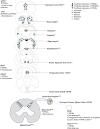PPARs and pain
- PMID: 29679493
- PMCID: PMC6487555
- DOI: 10.1111/bph.14339
PPARs and pain
Abstract
Chronic pain is a common cause of disability worldwide and remains a global health and socio-economic challenge. Current analgesics are either ineffective in a significant proportion of patients with chronic pain or associated with significant adverse side effects. The PPARs, a family of nuclear hormone transcription factors, have emerged as important modulators of pain in preclinical studies and therefore a potential therapeutic target for the treatment of pain. Modulation of nociceptive processing by PPARs is likely to involve both transcription-dependent and transcription-independent mechanisms. This review presents a comprehensive overview of preclinical studies investigating the contribution of PPAR signalling to nociceptive processing in animal models of inflammatory and neuropathic pain. We examine current evidence from anatomical, molecular and pharmacological studies demonstrating a role for PPARs in pain control. We also discuss the limited evidence available from relevant clinical studies and identify areas that warrant further research. LINKED ARTICLES: This article is part of a themed section on 8th European Workshop on Cannabinoid Research. To view the other articles in this section visit http://onlinelibrary.wiley.com/doi/10.1111/bph.v176.10/issuetoc.
© 2018 The British Pharmacological Society.
Conflict of interest statement
The authors declare no conflicts of interest.
Figures

Similar articles
-
Targeting nociceptive transient receptor potential channels to treat chronic pain: current state of the field.Br J Pharmacol. 2018 Jun;175(12):2185-2203. doi: 10.1111/bph.14044. Epub 2017 Nov 6. Br J Pharmacol. 2018. PMID: 28924972 Free PMC article. Review.
-
Spinal α2 -adrenoceptors and neuropathic pain modulation; therapeutic target.Br J Pharmacol. 2019 Jul;176(14):2366-2381. doi: 10.1111/bph.14580. Epub 2019 Mar 6. Br J Pharmacol. 2019. PMID: 30657594 Free PMC article. Review.
-
Calcium channel modulation as a target in chronic pain control.Br J Pharmacol. 2018 Jun;175(12):2173-2184. doi: 10.1111/bph.13789. Epub 2017 Apr 26. Br J Pharmacol. 2018. PMID: 28320042 Free PMC article. Review.
-
Challenges in translational drug research in neuropathic and inflammatory pain: the prerequisites for a new paradigm.Eur J Clin Pharmacol. 2017 Oct;73(10):1219-1236. doi: 10.1007/s00228-017-2301-8. Epub 2017 Sep 11. Eur J Clin Pharmacol. 2017. PMID: 28894907 Free PMC article. Review.
-
α9-containing nicotinic acetylcholine receptors and the modulation of pain.Br J Pharmacol. 2018 Jun;175(11):1915-1927. doi: 10.1111/bph.13931. Epub 2017 Jul 30. Br J Pharmacol. 2018. PMID: 28662295 Free PMC article. Review.
Cited by
-
Effects of Intra-BLA Administration of PPAR Antagonists on Formalin-Evoked Nociceptive Behaviour, Fear-Conditioned Analgesia, and Conditioned Fear in the Presence or Absence of Nociceptive Tone in Rats.Molecules. 2022 Mar 21;27(6):2021. doi: 10.3390/molecules27062021. Molecules. 2022. PMID: 35335382 Free PMC article.
-
Potential Therapeutic Effects of Short-Chain Fatty Acids on Chronic Pain.Curr Neuropharmacol. 2024;22(2):191-203. doi: 10.2174/1570159X20666220927092016. Curr Neuropharmacol. 2024. PMID: 36173071 Free PMC article. Review.
-
Building and Testing PPARγ Therapeutic ELB00824 with an Improved Therapeutic Window for Neuropathic Pain.Molecules. 2020 Mar 3;25(5):1120. doi: 10.3390/molecules25051120. Molecules. 2020. PMID: 32138198 Free PMC article. Review.
-
Novel findings regarding the role of the endocannabinoid system in pediatric functional gastrointestinal disorders.Pain Rep. 2025 Jun 16;10(4):e1273. doi: 10.1097/PR9.0000000000001273. eCollection 2025 Aug. Pain Rep. 2025. PMID: 40528842 Free PMC article.
-
Pharmacological Treatment of Chemotherapy-Induced Neuropathic Pain: PPARγ Agonists as a Promising Tool.Front Neurosci. 2019 Aug 28;13:907. doi: 10.3389/fnins.2019.00907. eCollection 2019. Front Neurosci. 2019. PMID: 31555078 Free PMC article. Review.
References
-
- Ahern GP (2003). Activation of TRPV1 by the satiety factor oleoylethanolamide. J Biol Chem 278: 30429–30434. - PubMed
-
- Ambrosino P, Soldovieri MV, De Maria M, Russo C, Taglialatela M (2014). Functional and biochemical interaction between PPARα receptors and TRPV1 channels: potential role in PPARα agonists‐mediated analgesia. Pharmacol Res 87: 113–122. - PubMed
Publication types
MeSH terms
Substances
LinkOut - more resources
Full Text Sources
Other Literature Sources
Medical

